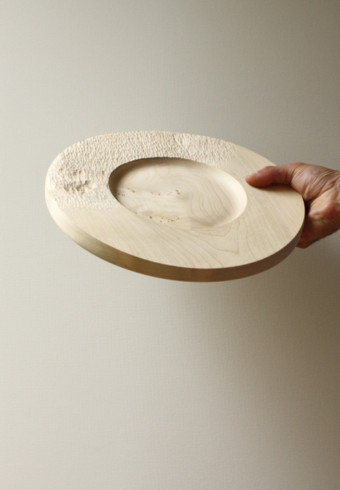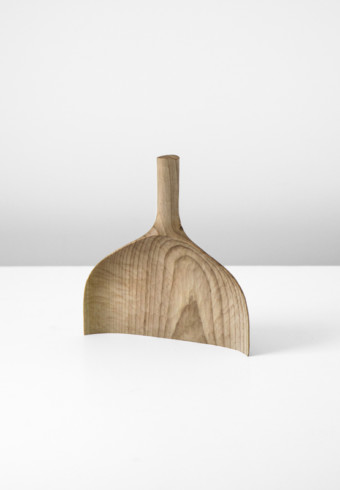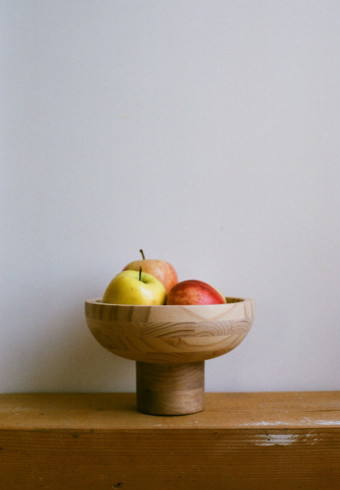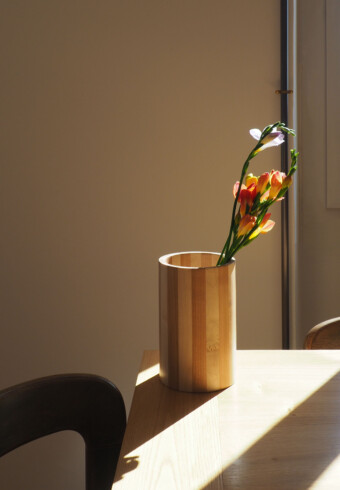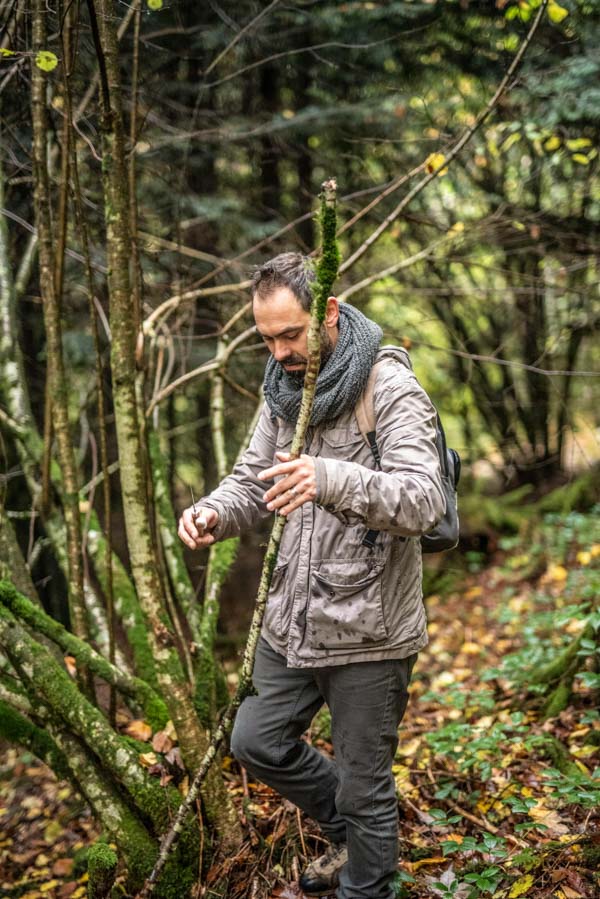
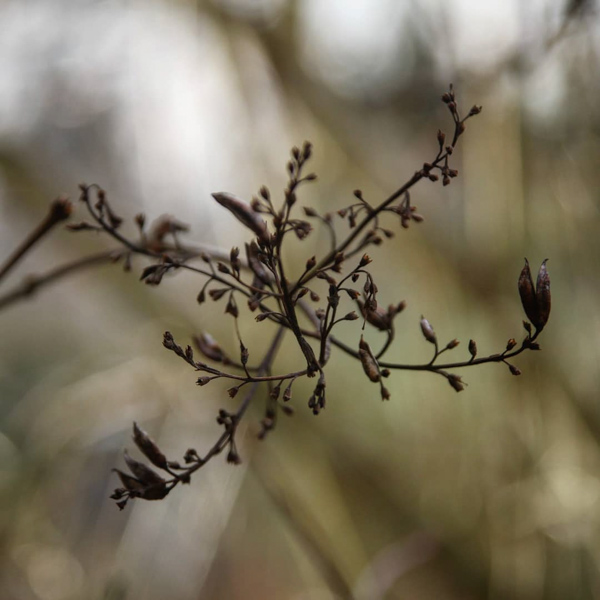
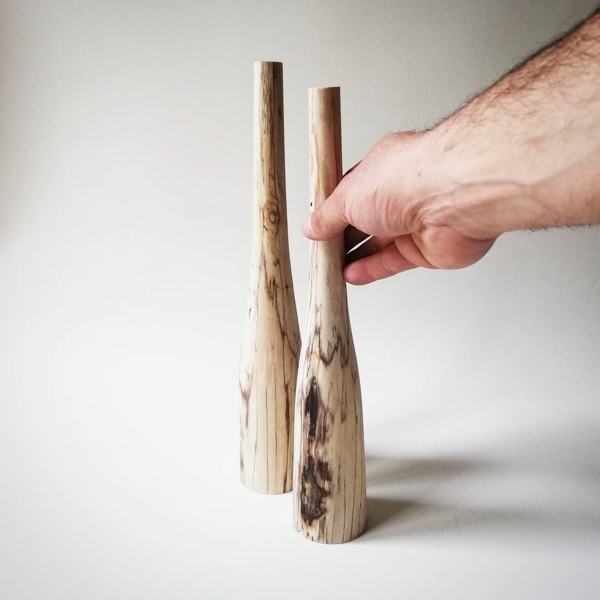
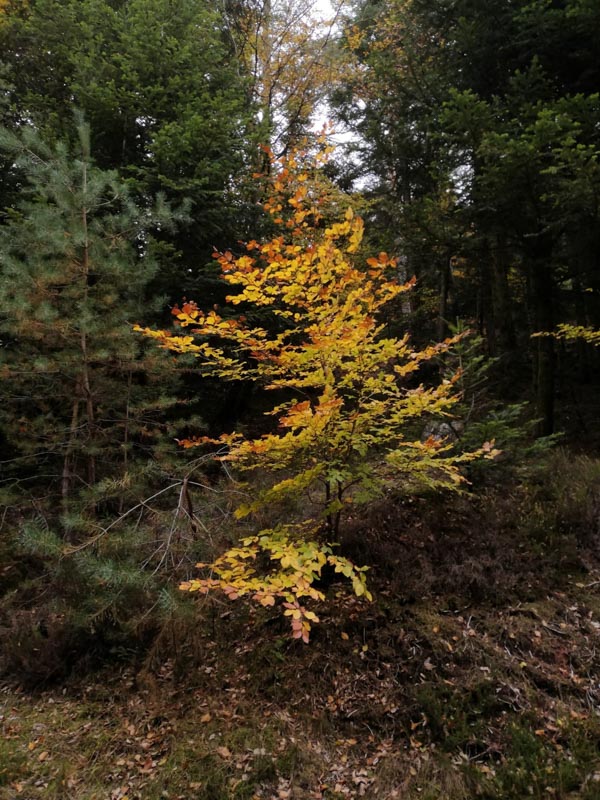
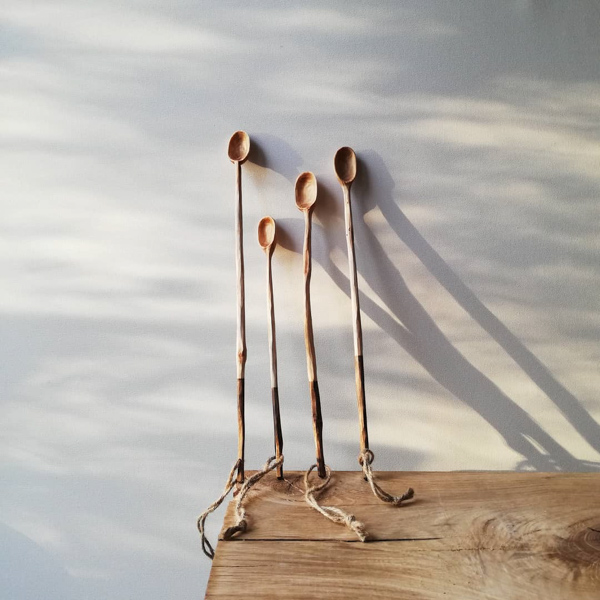
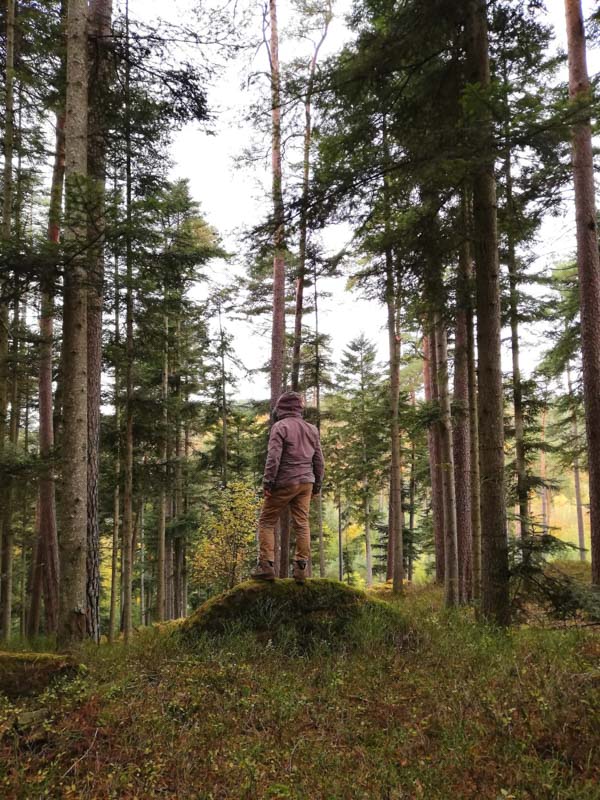
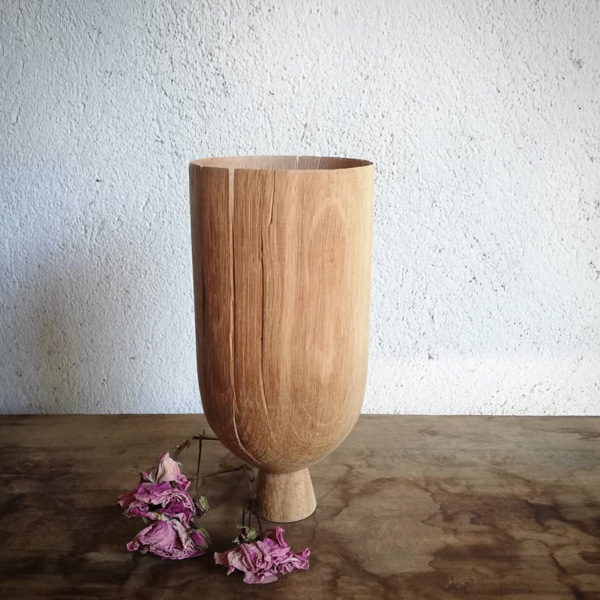
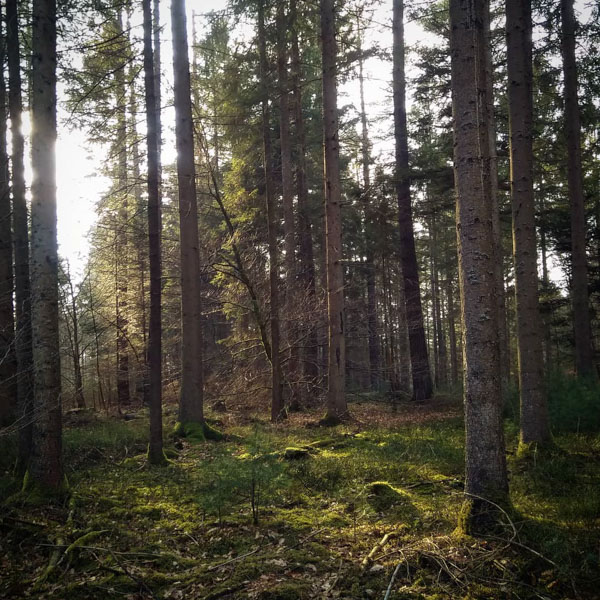
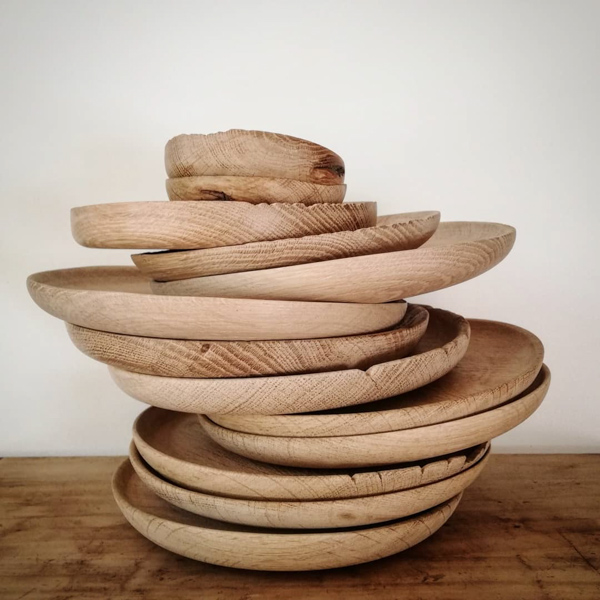
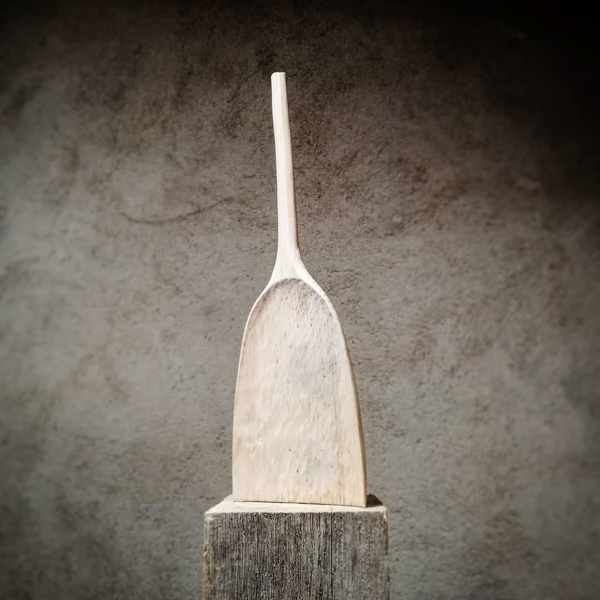
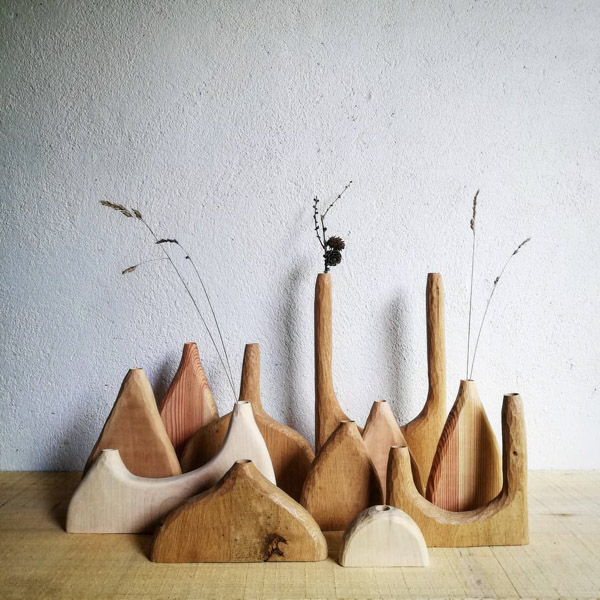
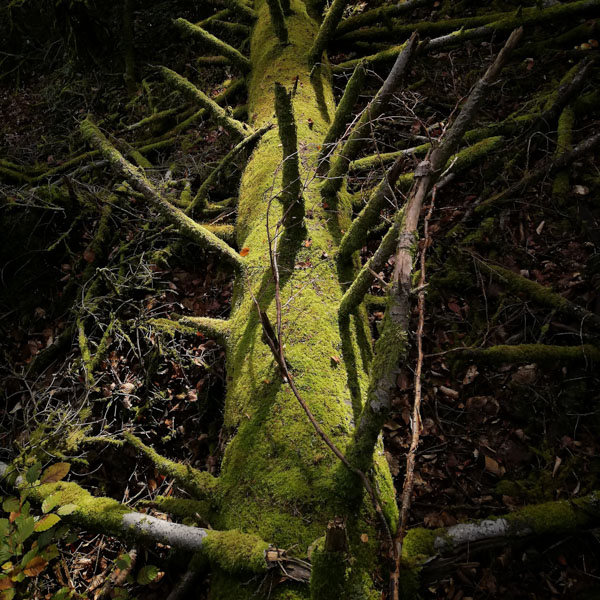
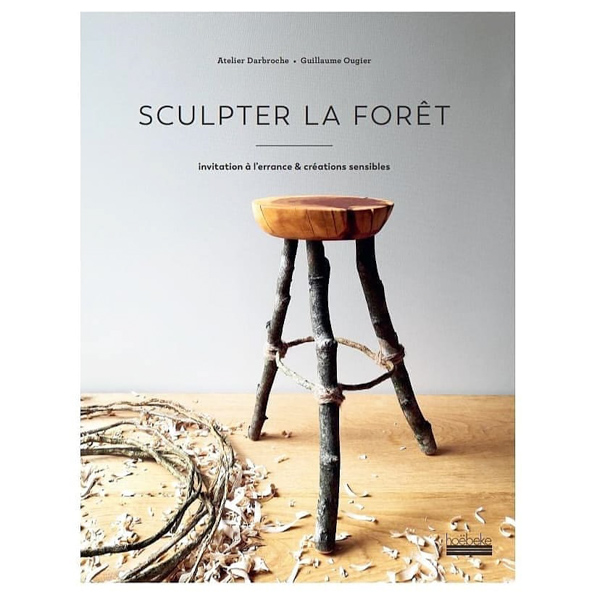
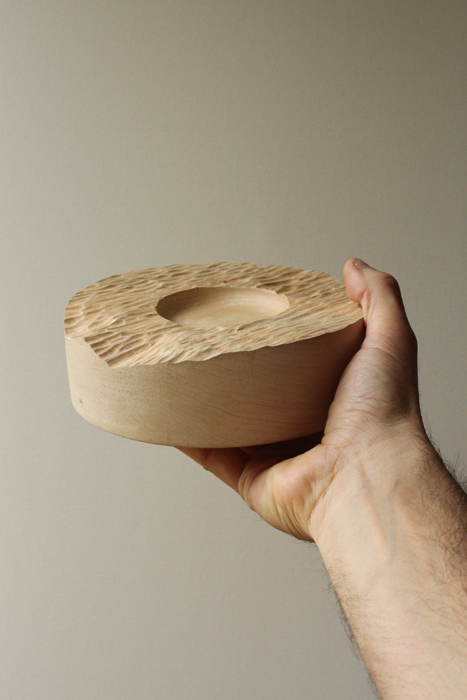
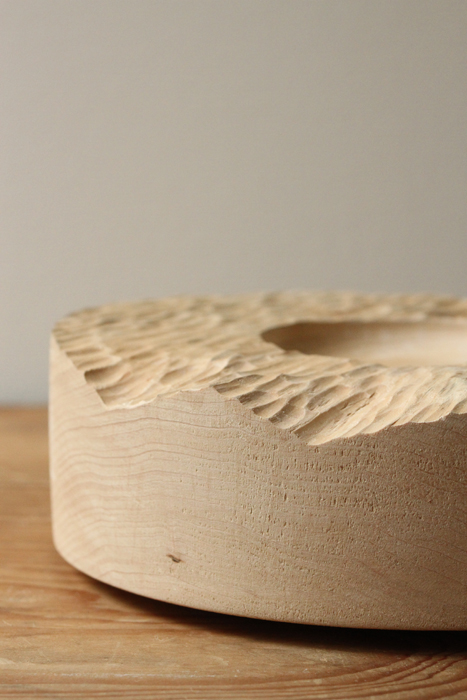
Atelier Darbroche

In the heart of the Vosges, Guillaume created the Atelier Darbroche. Here, he finds a much desired link with earth, matter, and time. With a deep respect for wood, he shapes unique pieces, guided by the natural curves of the tree. With the desire to produce responsibly, locally and sustainably, Guillaume offers his vision of modern craftsmanship. During a reading, he invites us to discover his universe.
Tell us about your background, how did you get into woodworking?
It has been a long road, nourished by different life and learning experiences that have been offered to me so far. I come from Literature, Philosophy and the Arts, I continued research until obtaining a DEA which led me to work for a little over two years in the forest. There, closer to Nature, I reflected on the place of man's gesture within the wild, to the potentialities offered by the book as a collection, and by the page in terms of a wall on which it is possible to hang things. I quickly realized that the book object could then be a nomadic exhibition space, which could contain the places and what they initiated.I believe that these moments spent far from everything built, when things seemed so obvious to me, were decisive for the future. And then I became a photographer. Capture, freeze the fleeing moments. Fighting against time.
Since childhood, I have always walked a lot with my parents, learned a taste for effort, the landscape, the solitude, the fragility of Nature. It is a real gift, perhaps the most precious transmission they have given me. I also believe that the endless times spent in my grandparents' house in the Hautes Vosges, surrounded by fields, woods, walking on the rocks of the river below, intensified my relationship with the Forest.
And then there was the small workshop of my elders, in which I liked to spend time as a child. This place full of old tools hanging on the walls, planes, saws and chisels, dust and sawdust on the floor, cobwebs on the tiles. Something of the order of timelessness. The trace of a memory so powerful that it came to light, one day. And the desire, above all, the need to reconnect the things that made fundamental sense to me, because they are part of my history, of my journey. Think about creation, the words that dance in my head, the photograph that immortalizes and keeps track. It took me some trials to end up refocusing the trail under my feet. And then it all came together. I was going to touch up some wood, because that's where I'm really from.
How do you view this practice?
Basically like a romantic relationship. I believe that I need to take time, to let things happen, I have full confidence in the material to guide me and show me where to go. It's about listening, learning. Each wood is different and teaches something new. You have to put yourself in a constant listening posture, and allow yourself to be receptive to what the Trees tell. It is a practice that I see as inherently slow. Because it is above all necessary to understand, weigh, observe, touch and guess, but above all not to try to constrain. Things always seem to me to be already contained, and I like to believe that I am only a conveyor of forms, a modest revealer who converses with matter.
Within the framework of my practice, I do not necessarily seek a complex aesthetic line, I like to be as close as possible to the simplicity of the forms and the obviousnesses that the material that I am working on gives me. The curves are meant to be soft, the surfaces sometimes remain raw. And it's about dealing with hazards, knots, fractures, strengths and weaknesses. I never forget that the woods in my hands are Trees, that they have taken decades to grow, and that we owe them, in fact, respect. Because they have a lot to teach. Things of the order of cohabitation, protection, slowness. They are models, sources of inspiration.
I basically don't create much, because I think you have to adapt your rhythm to the one that gave birth to these woods. First of all, to the best of my convictions. When I turn objects, the circle from which a shape emerges brings me back, it's a fair return of things. A way of bringing the permanence of the past back to center stage. The circle tells a lot, everything is contained, everything is in it. A circle is an absolute shape, I always look for them in the simple beauties of nature, in pebbles, leaves or the trace of a ray of sun on the ground between the branches. The circle is this great whole in which we are all, where everything must be balanced in relation to the others, and where respect for the Living takes precedence.
I also like to approach the material with simple tools, a knife, a plane, a rasp. These are other breaths. The practices of wood are so multiple, the essences so plural, that I cannot -not want to constrain myself to a single approach. When I engrave surfaces, it is to regain the sensitivity of the bark under the fingers. The Forest again inside, in the studio.
You have a special relationship with the forest. How do you approach it in your creative process?
Primordial even. This is where it all was born. And that's where I find strength and conviction. I spend a lot of time walking, observing, feeling. To take photographs too, because I need to keep track of the atmospheres, of the transmissions offered. The Forest is for me the only place of possibilities. It is a totally open place, and which at the same time provokes the fact of closing in on oneself, it is an interior to the exterior, where it is precisely possible for me to really find myself. There are no doors, no barriers, just an infinity of paths to be traced without leaving any traces. With the Trees, I'm still that kid who always walks around with a small knife in his pocket, and who reconnects with freedom, carelessness and naivety. Because I need to keep it all going.
In the image, I try to convey in my turn, when I share them on the workshop's Instagram page among others, the fleeting sensations and beauties. Tiny worlds. Mists and lines of light. The wild life. In my approach to creation, wood, words and images form a great inseparable whole. One serves and contributes to the other, in an incessant coming and going.
I write a lot in the Forest, as close as possible to the source, I always have a notebook and a pencil, because it is in situ that the words are the strongest, and that they are offered to me most clearly. So not to forget, as with photography, I keep track of the moment.
The Forest is inspiration, even breathing, vital. And the more time passes, the more I need it. She calls me incessantly, whispers simple words to me, and calls me back to a gentle serenity. The Vosges mountains where I come from, eroded and rounded, also say this. These are wild lands, made of trees and rocks, which inspired the very name of the workshop. The forest in the slopes, omnipresent, is, more than a playground, a house, the room of my memories and the original place which allows the existence of Darbroche. I owe him everything.
How do you characterize your pieces? What universe are you trying to build through them?
Above all, I try to relate. An impression, the slowness, the silence. The objects in the workshop are pieces that are almost obvious to me, modest and raw, sensitive in their visualization I hope. I would like to be able to awaken to the simplicity that I find in the Forest.
Without looking for complex lines, I rather let myself be carried by the fiber, always in this attentive listening posture. Wild things seem to me to be so much of themselves, in equilibrium, in a situation of equity in relation to each other, that I would like to be able to intervene as little as possible in the end. Just trying to transcribe, sometimes to reveal what is already there. I often speak of equi-vivre, it is really this underlying idea that drives my practice. Find this precise point where the wood leads me, located just before the "excess", where the material tells me "enough".
I would like to stay as close as possible to simplicity, because it is this which is blown to me in the woods. This does not prevent experiments or research, it is moreover a permanent learning, as in any artisanal practice I think, where learning knows no end, but what prevails remains despite everything the proximity to the material, the relation of the tool hand to the fiber, and by extension, of the hand to the Tree. The Forest inside, which we believe to be distant, other and elsewhere, while it is always right there, nearby.
If my proposal leads the public towards an awareness of fragile beauty and a greater respectful proximity to the living Savage, then the workshop finds its true justification there. I am deeply committed to using my mediums of expression in order to open up the field of possibilities, and to lay the foundations for the expression of things that are really important to me: awareness of environmental causes, preservation of the alive, the primary consideration of the importance of Nature in our lives, because we are nature, even if we tend to forget it. It is a deep commitment, which wakes me from sleep and shows me how to move forward.
Your practice is de facto linked to the notion of responsibility and sustainability. How is this expressed in the design of your pieces?
I think that we cannot create with Nature without having the concern of its protection. I feel responsible, from a young age, and guarantor of this idea that nothing has more meaning than the existence of Nature. In fact, it was natural to consciously deploy means of creation that are in line with these reflections so deeply rooted, because justified, I am not afraid to say it at all. I actually believe that we have a fundamental responsibility, which consists in having to necessarily be inserted in a process of existence and of life which is inclined to find cohabitation with the Wild Life. Once again, we are falsely modern beings, who fool ourselves behind pretenses of comfort, ease, pseudo-evolution. I believe that when you pick up a piece of wood, it comes back to the absolute base. At the origins. Stone smashed, earth spat, wood chipped.
So indeed, my practice finds part of its reality, it is true, thanks to the electricity necessary for the filming, it is for this reason that I like to vary the approaches and the relations with the material, I I actually even need it, and spending time carving spoons with a knife, cutting boards with a hand saw, working the edges with a palm plane, brings me back to this quieter, less energy-consuming front end. So I try to pay particular attention to all stages of the process. Sourcing wood, exclusively local, represents an important part of the mission. I never have a Tree cut, and I feel more satisfaction in working with old, forgotten, recovered, patiently sought wood. I like to excavate the piles of abandoned boards, to select fragments of trunks and branches fallen in forest plots or orchards of friends. Also at the mercy of chance, wanderings, encounters. I don't source wood with the idea of creating particular objects, but rather let the wood suggest the pieces that I might be able to make. With all the risks that this implies, but which make the journey so rewarding.
It is exactly the same with products applied to finished parts. I make my wood butter from the wax of a beekeeper friend whose hives are very close, with organic oils. The shipping packaging is recycled / clable as much as possible, and I still have to move forward on a lot of points that still concern me.
The intention contained being above all that it must be possible to abandon a soliflore, a vase or a sculpted tray in full Nature without it generating any impact on the ecosystem.
Can you present us the pieces that you shape?
Also with this idea of the preciousness of the material, I believe that it is important to never forget that each fragment of wood that enters the workshop comes from a Tree that has lived through the seasons, has fought, was sometimes abused, which required an inordinate growth time. Just to think that the oak or beech that is under my hands was born long before me calls for obvious respect. It is for this reason that in my eyes, the falls, the shavings, are always from this precious Tree. From this observation was born the collection Chut… still in progress, sculpted by hand in the silence of the song of the blade on the wood, in order to honor these discarded pieces.
I am also developing a series using leftover scraps, shavings and sawdust, always with the aim of saving material, optimizing and avoiding waste. The road is long but so rich when we think about sustainability, responsibility of the gesture with regard to Nature.
But I'm not an isolated case, I know that more and more of us are thinking about our practices in this way, and that's a good thing, I really believe. A counter-current which is justified, which I have a feeling of magnitude, is setting in more and more. Nothing is ever perfect, but I believe that the more we talk about it, the more these methods of action and creation will take hold and the more quickly this fundamental movement will develop. Because I believe fundamentally that it is necessary to rethink our relationship to the world, to the object, to consumption. The existence of the workshop is only a drop of water, but it is the drops that form the streams.
How do you feel inspired when you create new pieces?
By chance, above all, I believe. Every day is a new adventure, for which little is written beforehand. It's uncomfortable and exciting at the same time. Apart from the answers given to precise orders, which must respect certain specifications, I try especially to understand where I am located, on what perspective I find myself, before looking at which are the woods which today m 'call more than others, what tools could be useful.
Some raw pieces are a priori doomed to become bowls, where old boards will be carved trays. A log may contain a spoon, this misshapen piece a vase. I am especially very focused when I work, completely in the moment. Inspiration comes by doing. Sometimes it works, and sometimes it doesn't. I believe that I have within me forms, a line, a soft brutality that I try to extract and apply to what is created in the studio. The curves of my mountains, the touch of the bark, the simplicity of the moments lived in the Forest, again, the effort of walking deferred to that required during a shoot, everything ultimately is potentially a vector, a source.
As mentioned above, literature is at the heart of your thinking, both creative and intellectual. Where does it come from and what does it bring you?
Words tell just as much, in a different way, as pictures and woods. I was saying just before that the workshop was intrinsically based on the crossing of these three fields of expression, and that they are inseparable.
I come from the letter, I was awakened to Literature very early on by a French teacher in college, who laid the groundwork and initiated the path of my adventure with writing. Path which led me to studies of Philosophy also, before those of Arts.
I don't look for complexity in writing, like my woodworking practice, but rather simply to put down on paper the words that I pick up either in the Forest or in the workshop, when I talk to them. Woods. Instinctively, depending on the chain of sensations, obviously ultimately. The Forest is like a large book in which the sentences I take are often already written. I like to let thoughts and places, atmospheres, geographies, weather, rain, snow, fall, tell. It is enough to go from a thicket of bushy hazel trees to a dark fir forest for other sentences to emerge.
I like to tell what comes, what goes through me when I am sitting on a stump or looking at a landscape. These are plant words, the language of Nature as I feel it, in a very subjective way.
The writings are pendants of the image, which deliver an abstract part of the play of presence at the place and at the moment. The play of sounds, rhythms, associations provoke in me the same palpitations as when I observe wild spaces. I am not looking for anything in particular, no style, no inscription in any literary tradition, simply to transcribe, in a very personal way and without ambition, a part of the outside that touches me. I also believe that I seek above all, as I do with photography, to engrave a moment, specific to a place, a moment, a state of mind.
And when those who read these words tell me to be taken into the Forest, then I believe that I am touching on what I really want, to bring about a connection with the Savage.
It is this reconnection which is also the first subject of my book Sculpting the Forest (Ed Hoebecke), which came out in June 2020. The intimate link of the hand to the material, the wandering in the woods in reunion through a respectful creative process, the proximity to the places and the attention paid to the sensations felt. A work precisely around writing, photography and wood, so as not to be distant in belief, but to reconnect with the veracity close to the Savage.
You are very present on social networks, while you advocate a slower lifestyle, closer to nature. Is this a message you want to get across?
I am relatively present it's true, because I have at heart to take the public with me both on the roads but also in the workshop, as close as possible. Social networks are the link. The exchange surface. The window through which I maintain the relationship with the other and elsewhere. To better suggest and initiate the possibility that everyone has to really get closer to Nature in turn, or in any case the need to respect it, even from a distance. In its choices, its purchases, its way of life, its consumption of the world.
Going alternately from the photographed and written Forest to the studio allows me to constantly bridge the gap between the primary places of birth of Darbroche and the hut where things materialize.
With this intention of sharing, there is also the desire to tell - without speaking there in any way about the transmission of knowledge, I do not pretend to do so. When I started woodturning, I announced it to the people who were following the adventures of the workshop at the time, explaining that I was embarking on something new, an extension of my approach to the material. thanks to a tool that was unknown to me until then, and that I wanted to bring about all this before their eyes, transparently, with the errors, the failures, the small successes that would imply. I myself am always curious about the fact of discovering workshops, things in the process of being done, and I said to myself that it would perhaps be interesting to unveil the day-to-day stages of a journey in (re )birth. In an inclusive and participatory manner. I believe that networks have the strength of being able to bring people together, potentially breaking distances and filters, and also federating, if they are used in a fair and honest manner. The doors of the workshop are always open thanks especially to the Instagram page, and I think it is possible to be aware of today's world and in a great misunderstanding of it while being a little socialized , even if deep within me, I continue to look for my place in this era, and despite everything I remain a bear at the bottom of his hut and who likes to go for a walk alone in the middle of the Forest ...
Tell us about these two pieces presented for the OROS Market.
The two pieces presented come from the Collection entitled ๏ 1. They are sets shot by ash et sycamore Vosges. The pallor of the woods really speaks to me a lot. This lunar hue. Moreover, the circle refers to it here completely. White in the night.
These are objects to put down, to put down. I like to see them in dark, dim spots of light. I create many more pieces to watch than to use elsewhere. But beyond that, it is the work of engraving that interests me on this collection. The texture, like a simulacrum of bark under the fingers. Rediscover the sensation of the skin of the tree, eyes closed. Spaces reworked with a gouge are not necessarily homogeneous, they come to terms with the nature of the fibers, let themselves be carried away by the accidents of the wood, sometimes disappear in the very mass of the material, as if they were in movement. I like to look for almost smoothness during the filming stage, to approach the surfaces again afterwards, even if it is far from being systematic.
In the act of engraving, there is a crude act of archeology, it is going under the veil, more in depth, under the visible layers. Explore the material in its secret. In this approach to stratification, I rediscover the attachment to memory, which makes it possible to bring back those buried in memory. In the same way as when we count the growth rings of the Tree, we can go back in time. And maybe even slow it down.
The race for the after, unreasonable, resurfaces here again, in favor of the slowness of the gesture, small cut by small cut, which allows to re-register the object in a human rhythm, far from the false standards of the industry which dis- personifies, standardizes, kills and smooths any link to true value. In craftsmanship, in creations that involve the hand, there is always sweat, doubts, questions, blood, abandonment, emptiness and imperfection. A bit of the one who conversed with the material, sharing time.
What future for crafts according to you?
I keep in me a conviction, which tells me that in these current times, the makers, those who create with their hands have a responsibility between their fingers. It is possible for us to redefine this entire period of our collective history, to put back the signs indicating a path for tomorrow. The “now” invites us to be in a listening posture, to work together to create what we want for the future. By going back to the origins. And it is precisely there that those close to raw and pure material can help to redraw the contours, because making with his hands today contains in filigree the premises of the first acts of art and expression. Messages supported by actions. We are ready to take on this role I believe. Handicraft, handmade is not a fashion, but a truth that has always existed, carrying, inscribed in it, the invitation to reconnect with the obviousness of simple rhythms, which reminds us that the living, whether it is Plant, Animal or Human, is subject to the same common rules, and that one does not take precedence over the other. Awareness, projection and sustainability. For the balance of Living.
Find a selection of her pieces on our Online Store, Creators tab.














- Photographer: Portrait Olivier Cochard, Others Atelier Darbroche
- Location: Vosges, France
- Website: https://www.atelierdarbroche.fr
Share
